工业工程的介绍 毕业论文外文翻译
介绍工业工程专业英文
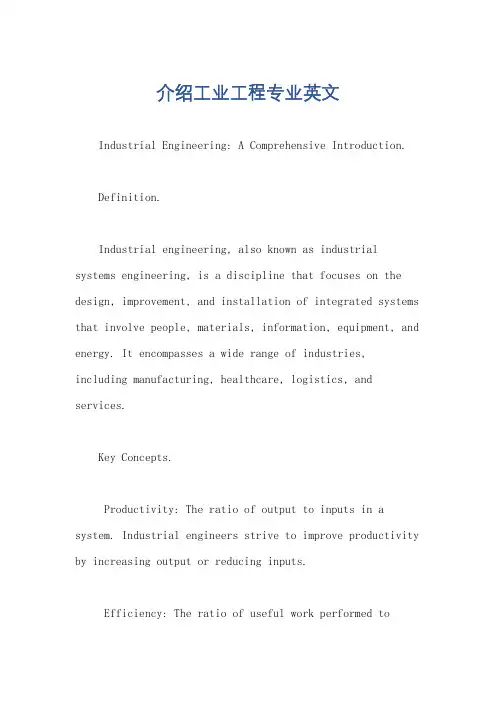
介绍工业工程专业英文Industrial Engineering: A Comprehensive Introduction.Definition.Industrial engineering, also known as industrial systems engineering, is a discipline that focuses on the design, improvement, and installation of integrated systems that involve people, materials, information, equipment, and energy. It encompasses a wide range of industries,including manufacturing, healthcare, logistics, and services.Key Concepts.Productivity: The ratio of output to inputs in a system. Industrial engineers strive to improve productivity by increasing output or reducing inputs.Efficiency: The ratio of useful work performed tototal work done. Industrial engineers seek to maximize efficiency by reducing waste and optimizing resource utilization.Systems thinking: The approach of considering a system as a whole, rather than as a collection of individual components. Industrial engineers often use systems analysis techniques to identify and address system-level problems.Data analysis: The process of collecting, analyzing, and interpreting data to make informed decisions.Industrial engineers use data analysis to identify trends, patterns, and areas for improvement.Work measurement: The process of measuring the time and effort required to perform specific tasks. Industrial engineers use work measurement to set work standards, establish production quotas, and identify areas for optimization.Roles and Responsibilities.Industrial engineers play a variety of roles and responsibilities in organizations, including:Process improvement: Analyzing and improving existing processes to increase efficiency, reduce costs, and improve customer satisfaction.Layout design: Designing and optimizing the physical layout of facilities, including factories, warehouses, and offices.Production planning and control: Developing and implementing plans to control production processes, including scheduling, inventory management, and quality control.Ergonomics: Designing workplaces and equipment to optimize human performance, reduce fatigue, and prevent injuries.Supply chain management: Coordinating the flow of materials, information, and resources throughout a supplychain, including supplier selection, inventory management, and logistics.Education and Training.Industrial engineering degrees are typically offered at the undergraduate and graduate levels. Undergraduate programs typically require coursework in mathematics, statistics, physics, engineering mechanics, industrial engineering principles, and business management. Graduate programs often specialize in specific areas, such as manufacturing, logistics, or healthcare.In addition to formal education, industrial engineers often pursue professional certification through organizations such as the Institute of Industrial Engineers (IIE). Certification demonstrates a high level of knowledge and experience in the field.Career Opportunities.Industrial engineers are in high demand in a wide rangeof industries. Career opportunities include:Manufacturing engineer.Process improvement engineer.Supply chain manager.Ergonomist.Operations research analyst.Business analyst.Benefits of Industrial Engineering.Industrial engineering can provide significant benefits to organizations, including:Increased productivity: Industrial engineers help organizations improve productivity by optimizing processes, designing efficient layouts, and implementing data-drivensolutions.Reduced costs: Industrial engineers identify and eliminate waste, reduce inventory levels, and improve supply chain efficiency, leading to lower operating costs.Improved quality: Industrial engineers implement quality control measures and use data analysis to identify and address quality issues, leading to improved customer satisfaction.Enhanced safety: Industrial engineers design workplaces and equipment to minimize risks and prevent injuries, creating a safer work environment.Increased innovation: Industrial engineering methodologies can be applied to new product development, process design, and service delivery, leading to innovative solutions.Conclusion.Industrial engineering is a challenging and rewarding field that offers a wide range of career opportunities. Industrial engineers play a vital role in improving the efficiency, productivity, and safety of organizations across all industries. By applying systems thinking, data analysis, and problem-solving skills, industrial engineers can make a significant contribution to the success of their organizations.。
工业工程专业英语(推荐5篇)
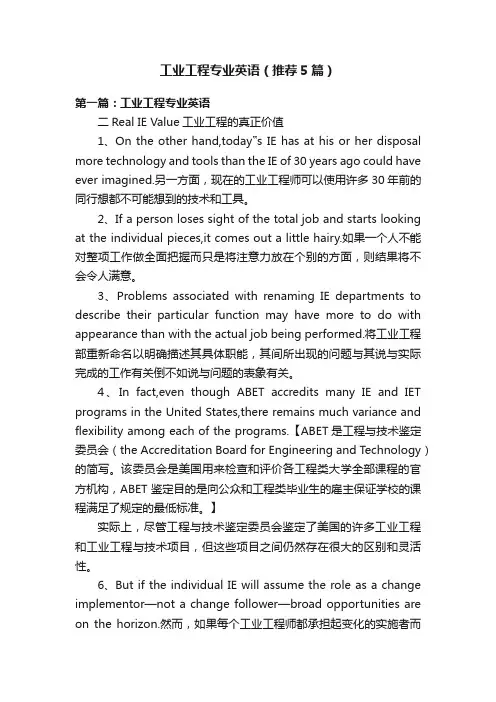
工业工程专业英语(推荐5篇)第一篇:工业工程专业英语二Real IE Value工业工程的真正价值1、On the other hand,today‟s IE has at his or her disposal more technology and tools than the IE of 30 years ago could have ever imagined.另一方面,现在的工业工程师可以使用许多30年前的同行想都不可能想到的技术和工具。
2、If a person loses sight of the total job and starts looking at the individual pieces,it comes out a little hairy.如果一个人不能对整项工作做全面把握而只是将注意力放在个别的方面,则结果将不会令人满意。
3、Problems associated with renaming IE departments to describe their particular function may have more to do with appearance than with the actual job being performed.将工业工程部重新命名以明确描述其具体职能,其间所出现的问题与其说与实际完成的工作有关倒不如说与问题的表象有关。
4、In fact,even though ABET accredits many IE and IET programs in the United States,there remains much variance and flexibility among each of the programs.【ABET是工程与技术鉴定委员会(the Accreditation Board for Engineering and T echnology)的简写。
关于工业工程的英文作文
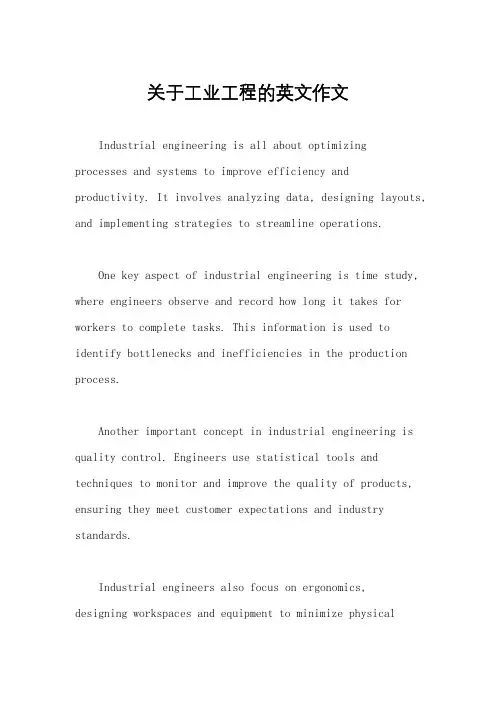
关于工业工程的英文作文Industrial engineering is all about optimizing processes and systems to improve efficiency and productivity. It involves analyzing data, designing layouts, and implementing strategies to streamline operations.One key aspect of industrial engineering is time study, where engineers observe and record how long it takes for workers to complete tasks. This information is used to identify bottlenecks and inefficiencies in the production process.Another important concept in industrial engineering is quality control. Engineers use statistical tools and techniques to monitor and improve the quality of products, ensuring they meet customer expectations and industry standards.Industrial engineers also focus on ergonomics,designing workspaces and equipment to minimize physicalstrain and maximize productivity. By considering human factors, engineers can create safer and more efficient work environments.In addition to optimizing processes, industrial engineers also play a role in supply chain management. They work to ensure that materials and resources are efficiently sourced, transported, and utilized to minimize waste and reduce costs.Overall, industrial engineering is a dynamic and multidisciplinary field that combines elements of engineering, business, and psychology to improve processes and systems in various industries. It is essential for organizations looking to stay competitive and maximizetheir potential for growth.。
工业工程专业英语翻译(3)

什么问题可能会在如此明亮的机会阵列上投下阴影呢?对于初学者来说,随着工业工程新的机遇的产生,诸如工业工程师到底能胜任什么样的工作问题也随之产生。
At one time, it was easier to define what an IE did .” Industrial engineering was simple in those days when we dealt with methods, work standards and work simplification,” says Carlos Cherubin, director of engineering for The Limited Co. “But there has to be some way to get past the old industrial engineering definition.”
值得一提的是,工业工程现在有更多的机会去集中于现在许多企业已经视为独立的学科的众多领域中的一个-----包括防真学、运筹学、人因学、物料搬运和物流学。
The name game
命名问题
What problems could possibly throw a shadow on such a bright array of opportunities? For starters, as new opportunities have developed for the IE, new questions have formed about what types of jobs the industrial engineer is qualified to perform.
工业工程师非常善于解决问题。可是具有讽刺性的却是他们仍有一个长期性的问题得不到解决----一致性。而且这个问题解决起来一直很困难。事实上,“一致性”恰好是目前工业工程领域所面临的众多挑战性问题之一。
工业工程专业英语最全翻译
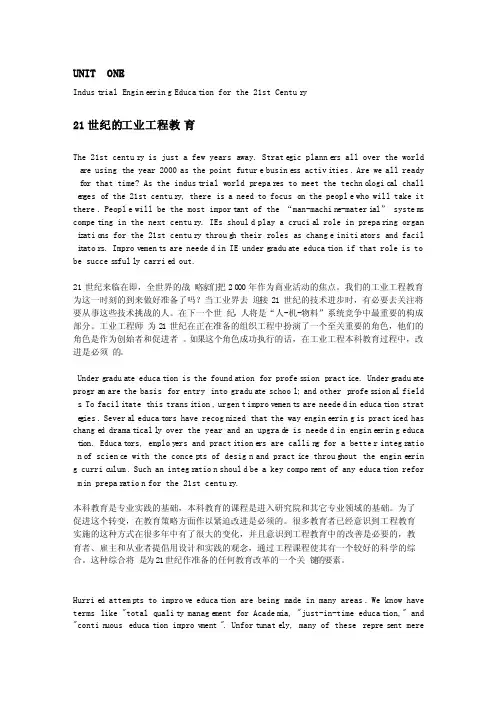
UNIT ONEIndust rialEngine ering Educat ion for the 21st Centur y21世纪的工业工程教育The 21st centur y is just a few yearsaway. Strate gic planne rs all over the world a re usingthe year 2000 as the pointfuture busine ss activi ties.Are we all ready f or that time? As the indust rialworldprepar es to meet the techno logic al chall e n gesof the 21st centur y, thereis a need to focuson the people who will take it there. People will be the most import ant of the “man-machin e-materi al” system s compet ing in the next centur y. IEs should play a crucia l role in prepar ing organ i z atio ns for the 21st centur y throug h theirrolesas change initia torsand facil i t ator s. Improv ement s are needed in IE underg radua te educat ion if that role is to be succes sfull y carrie d out.21世纪来临在即,全世界的战略家们把2000年作为商业活动的焦点。
工业工程专业简介BriefIntroductiontoIndustrialEngineering
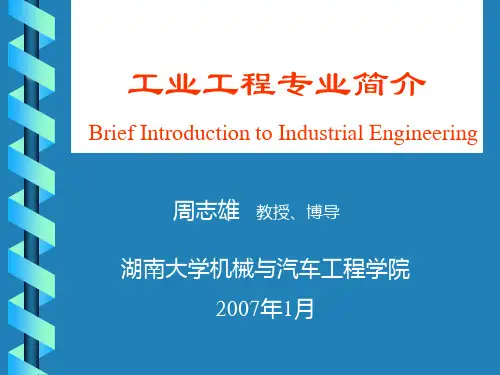
企业效益 增加
说明:市场份额增加50%是很困难的。
工业工程在美国的应用
行政管理:
Government Administration
医疗卫生:
Health care system 信息系统 交通网络的设计 金融证券分析 电子商务 门诊的流程图记录 后勤保障系统 决策支持系统 顾客需求与运输计划 投资理财评估 物流服务 急救中心的配置 赛场运输问题 电子政务 车辆调度 税率优化 顾客满意度的优化 人员的工作调度 工作流优化 服务成本与质量 工作研究
工业工程在我国的应用历程
追溯到50年代初期,不自觉的应用基础工业工程 文革期间(1966~1976),IE的科学管理方法被当作资本主义加以排斥; 1987年实行经济体制改革与对外开放; 1985年较大规模的有组织的IE应用; 1989年举行了中国首届IE学术会议,成立了中国机械工程学会IE分会; 1992年教育部首先在天大与西交大设立IE专业,目前已有100所左右的 高校设立了IE专业; 从1994年开始每年都举行IE&EM国际会议
金融证券:
Financial & Stock
体育竞赛:
1996 Atlanta Olympics
交通运输:
其他服务
Services Transportation
工业工程师在美国
企业都设有工业工程部,1990年IE工程师人 数占所有工程师8.9%,到2000年增加到19%;现 在IE工程师20万,IE工程师已成为工程师类职业
我校工业工程的情况
工业工程的形成与发展
泰
勒
(Frederick W. Taylor)
科学管理之父、 工业工程的先驱
1776, 史密斯(英)
工业工程生产线中英文对照外文翻译文献
中英文对照外文翻译(文档含英文原文和中文翻译)A solution= procedure for type E simpleassembly line balancing problemAbstract:This paper presents a type E simple assembly line balancing problem (SALBP-E) that combines models SALBP-1 and SALBP-2. Furthermore, this study develops a solution procedure for the proposed model.The proposed model provides a better understanding of management practice that optimizes assembly line efficiency while simultaneously minimizing total idle time. Computational results indicated that,under the given upper bound of cycle time (ct max), theproposed model can solve problems optimally with minimal variables, constraints, and computing time.Keywords Simple assembly line balancing problem, Type E simple assembly line balancing problem,Manufacturing optimization.1.IntroductionIt has been over five decades since researchers first discussed the assembly line balancing problem (ALBP). Of all kinds of ALBP, the most basic is the simple assembly line balancing problem (SALBP). Bryton defined and studied SALBP as early as 1954. In the following year (1955), Salverson built the first mathematical model of SALBP and presented quantitative solving steps, which attracted great interest. After Gutjahr and Nemhauser (1964) stated that SALBP is an NP-hard combination optimization problem, the majority of researchers hoped to develop an efficient method to obtain the best solution and efficiently solve variant assembly line problems (e.g. Baybars, 1986; Boysen, Fliedner, & Scholl, 2007, 2008; Erel & Sarin, 1998; Ghosh & Gagnon, 1989; Scholl & Becker, 2005, 2006; Toksari, Isleyen, Güner, & BaykoÇ, 2008; Yeh & Kao, 2009). During subsequent years, SALBP became a popular topic. Kim, Kim, and Kim (1996) divided SALBP into five kinds of problems, of which type I problem (SALBP-1) and type II problem (SALBP-2) are the two basic optimization problems. Researchers have published many studies on the solution for the SALBP-1 problem. Salverson (1955) used integer programming (IP) to solve the workstation assignment problem. Jackson (1956) proposed dynamic programming (DP) to solve SALBP-1. Bowman (1960) developed two mathematical models and introduced 0–1 variables to guarantee that no tasks took the same time and thatno tasks were performed at different workstations. Talbot and Patterson (1984) presented a mathematical model with a single decision variable, and used it to calculate the number of tasks assigned to workstations. Essafi, Delorme, Dolgui, and Guschinskaya (2010) proposed a mixed-integer program for solving a novel line balancing problem composed of identical CNC machines. Hackman, Magazine, and Wee (1989) used a branch and bound (BB) scheme to solve SALBP-1. To reduce the size of the branch tree, they developed heuristic depth measurement techniques that provided an efficient solution. Betts and Mahmoud (1989), Scholl and Klein (1997, 1999), Ege, Azizoglu, and Ozdemirel (2009) have suggested BB methods for application. Other heuristics have been developed for solving the variant problems. These may include simulated annealing (Cakir, Altiparmak, & Dengiz, 2011; Saeid & Anwar, 1997; Suresh & Sahu, 1994), Genetic Algorithm (McGovern & Gupta, 2007; Sabuncuoglu, Erel, & Tayner, 2000), and ant colony optimization algorithm (Sabuncuoglu, Erel, & Alp, 2009; Simaria & Vilarinho,2009). Recently, multiple-objective problems have emerged from the diversified demand of customers. For example, Rahimi-Vahed and Mirzaei (2007) proposed a hybrid multi-objective algorithm that considers the minimization of total utility work, total production rate variation, and total setup cost. Chica, Cordon, and Damas (2011) developed a model that involves the joint optimization of conflicting objectives such as the cycle time, the number of stations,and/or the area of these stations. Another interesting extension is the mixed-model problem, which is a special case of assembly line balancing problem with different models of the product allowed moving on the same line. Aimed at the mixed-model assembly line problem, Erel and Gökçen (1999) studied onmixed-model assembly line problem and established 0–1 integer programming coupled with a combined precedence diagram to reduce decision variables and constraints to increase solving efficiency. Kim and Jeong (2007) considered the problem of optimizing the input sequence of jobs in mixed-model assembly line using a conveyor system with sequence-dependent setup time. Özcan and Toklu (2009) presented a mathematical model for solving the mixed-model two-sided assembly line balancing problem with the objectives of minimizing the number of mated-stations and the number of stations for a given cycle time.Unlike SALBP-1, the goal of SALBP-2 is to minimize cycle time given a number of workstations. Most studies focused on solutions for SALBP-1, and not SALBP-2, because SALBP-2 may be solved with SALBP-1 by gradually increasing the cycle time until the assembly line is balanced (Hackman et al., 1989). Helgeson and Bimie presented a heuristic algorithm to solve SALBP-2 as early as 1961.Scholl (1999) presented several decision problems regarding the installation and utilization of assembly line systems, indicating that balancing problem is especially important in paced assembly line cases. Scholl used task oriented BB to solve SALBP-2 and compared it with existing solution procedures. Klein and Scholl (1996) adopted new statistical methods as a solution procedure and developed a generalized BB method for directly solving SALBP-2. In addition, Gökçen and Agpak (2006) used goal programming (GP) to solve simple U-type assembly line balancing problems, in which decision makers must consider several conflicting goals at the same time. Nearchou (2007) proposed a heuristic method to solve SALBP-2 based on differential evolution (DE). In the followingyear, Nearchou (2008) advanced a new population heuristic method base on the multi-goal DE method to solve type II problems. Gao, Sun, Wang, and Gen (2009) presented a robotic assembly line balancing problem, in which the assembly tasks have to be assigned to workstations and each workstation needs to select one of the available robots to process the assigned tasks with the objective of minimum cycle time. Several other methods have been reported in the literature. For example, Bock (2000) proposed the Tabu Search (TS) for solving SALBP-2 and extended TS using new parallel breadth, which can be used to improve existing TS programs for assembly line problems. Levitin, Rubinovitz, and Shnits (2006) developed a genetic algorithm (GA) to solve large, complex machine assembly line balancing problems by adopting a simple principle of evolution and the BB method. A complete review of GA to assembly line balancing problems can be found in Tasan and Tunali (2008).The rest of the paper is organized as follows. Section 2 introduces SALBP-E formulation and its solution procedure. Section 3 presents solutions to a notebook computer assembly model and some test problems using small- to medium-sized for numerical calculations. Finally, this paper concludes with a summary of the approach.2.Formulation and solution procedure of SALBP-E The SALBP-E model integrates the SALBP-1 and SALBP-2 models. For this purpose, the following notations and variables are defined as follows:Notations:n Number of tasks (i = 1, . . . , n) m Number of stations (j = 1, . . . , m) m max Upper bound of stations (j = 1, . . . , m max) m min Lower bound of stations (j = 1, . . . , m min) t i Operation time of task iCt Cycle timeP Subset of task (i, k), given the direct precedence relationsDecision variables:x ijε {0, 1} 1 if task i is assigned to station j 0otherwise ( "i; j = m min, . . . , m max)y jε {0, 1} 1 if any task i is assigned to station j 0otherwise (j = 1, . . . , mmax)ct ≥Cycle time is set to greater than or equal to 0M* Minimal number of stationsThe original SALBP-1 model is as follows:SALBP-1:生产线设备选择多目标的方法摘要:考虑10一月2012一个新的问题,处理设计的可重构自动加工线这种线是由工作站顺序处理。
工业工程英文介绍
2
Economic
Efficiency System performance
input
materials
People Equipment Energy Layout Technology …
output
Product or service
feedback
Evaluation standards
Time Quality Cost
investments in hardware. The production efficiency can be increased by 2 to 3 times, or even 5 to 10 times. Therefore, the prospects of industrial engineering are very bright. Industrial engineering is so powerful that various types of organizations will need more industrial engineers to make our life better!
Lean Production, LP
Value Engineering, VE
6
Present Situation of IE
• Employment Orientation
Manufacturing
Foreign-funded enterprises Joint ventures
Domestic enterprises
check
Continuous Improvement
3
Relationship to Other Engineering
工业工程专业英语每段对应翻译(全)
Unit1IntroductiontoIndustrialEngineeringTheRolesofIEIndustrialengineering?(IE)?is?emergingasoneoftheclassic*andnovelprofessionsthatwillbecountedforsolvingcomplexandsystematicproblemsinthehighlytechno-logicalworldoftoday.?Inparticular,withtherapiddevelopm entofChina’seconomyanditsactingasacenterofworldmanufacturingindustries,thedemandforIEwillin-creaseandwidencontinuouslyandurgently.工业工程是新兴的经典和新颖的将计算解决复杂和系统性的问题,在今天的高度科技世界职业之一。
,特别是在中国快速发展的经济和其作为世界制造业中心的演技,为IE的需求将增加,并不断扩大和迫切。
Aproductionsystemorservicesystemincludesinputs,transformation,andout-puts.Throughtransformation,theaddedvaluesareincreasedandthesystemefficiencyandeffectivenessareimproved.Transformationprocessesrelyonthetechnologiesusedandmanagementsciencesaswellast heircombination.生产系统或服务系统,包括输入,转换和输出。
通过改造,增加值的增加,系统的效率和效益都有所提高。
转化过程中所使用的技术和管理科学以及它们的组合依靠。
介绍工业工程专业英文
介绍工业工程专业英文English:Industrial Engineering is a field of engineering that focuses on optimizing complex systems or processes. It combines knowledge and skills from various disciplines such as engineering, business, and computer science to improve efficiency, productivity, and quality in organizations. Industrial engineers analyze data, develop solutions, and implement strategies to streamline production processes, reduce costs, and enhance overall performance. They use mathematical modeling, computer simulations, and optimization techniques to identify bottlenecks, enhance workflow, and eliminate waste in systems. Industrial engineering also involves knowledge of ergonomics, safety, and environmental sustainability to design workspaces that are efficient, safe, and environmentally friendly. Graduates of industrial engineering programs are equipped with the skills to work in a variety of industries such as manufacturing, healthcare, transportation, and consulting, where they can apply their problem-solving abilities and technical knowledge to drive continuous improvement and innovation.中文翻译:工业工程是一个专注于优化复杂系统或过程的工程领域。
- 1、下载文档前请自行甄别文档内容的完整性,平台不提供额外的编辑、内容补充、找答案等附加服务。
- 2、"仅部分预览"的文档,不可在线预览部分如存在完整性等问题,可反馈申请退款(可完整预览的文档不适用该条件!)。
- 3、如文档侵犯您的权益,请联系客服反馈,我们会尽快为您处理(人工客服工作时间:9:00-18:30)。
附录A 译文工业工程的介绍工业工程(Industrial Engineering﹐简称I.E.)是一门新兴的工程科学。
早在1881年左右,泰勒(Frederick W. Taylor)就已具有工业工程的观念,但实际上工业工程这门学问却在1920年代才开始,到二次大战后才略具雏型。
在国外,泰勒首先提倡「时学研究」,而纪尔布雷斯夫妇(F.B & Gilbreths)则为「工学研究」的创始人。
(编注:有关时学工学的起源,可看另页「工业工程的两个小故事」一文。
)直到1930年代他们的研究才受到大众的重视,而正式成为工时学(motion and time study),如今工时学可说是工业工程的领域中最基本的一部分,也是传统工业工程的基本观念。
当初,工时学的定义是指对于完成一项工作的操作方法、材料、工具与设备,及其所需的时间,加以研究。
而其目的在1.寻求最经济有效的工作方法;2.进一步确认并规定因此所选定的工作方法、材料标准、工具规格及设备要求的理想标准;3.研究并制定工人完工所需的标准时间;4.训练并切实实行新方法。
一、工业工程的定义美国工业工程师学会(AIIE)对工业工程的定义是:工业工程是对人员、物料及设备等,从事整个系统之设计改进及运用的一门科学。
它利用数学、自然科学与社会科学的专门知识及技巧,并利用工程分析与设计的原理和方法,来规划、预测,并评估由此及其有关系统中所获得的效果。
从上述的定义,读者或许可获知一个大概。
概括而言,所有人类及非人类参与的活动,只要有动作出现的,都可应用工业工程的原理原则,以及工业工程的一套系统化的技术,经由最佳途径达到目的。
譬如工业工程中的动作连贯性分析(operation sequence),由于人类的任何一种动作都有连贯性,因此把各动作经仔细分析,分成一个个微细单元,删掉不必要的动作,合并可连接的动作,以达到工作简化、动作经济、省时省工之目的。
二、工业工程的意识工业工程意识大体分为五个意识。
成本效率意识,系统意识,成功环境意识,简化和标准化意识,人本意识。
关于成本和浪费的意识,但当我们到一个企业真实去看的时候,我们经常会听到车间有人说,看我们车间所有的人都在忙,他认为这是一个环境很好的局面,但你仔细观察就会发现,忙与忙不一样。
例如,一个企业研发部,他们每年要开发几十个产品,每个人都很忙。
当你看到一些现象,你会问这些是浪费吗?举例来说,加工过剩的浪费,明明要求的加工精度是一毫米,你要加工到0.5毫米,领导认为工人干的比他要求的还好,但是从工业工程的角度来讲,这就是一种浪费,因为不需要。
还有如我们看到在车间现场有各种各样的搬运,如果从工业工程的角度来讲,所有的搬运都应该取消,因为搬运不产生任何的价值。
还有很多种浪费,如动作浪费、等待浪费等。
当你简单到车间走走就会发现,这些浪费的地方到处都是,而浪费掉的都是效益。
不能使原料变为产品的支作都是浪费工业工程另一个重要的意识是系统意识,工业工程永远强调你不要只关注单个的元素,你要关注整个系统。
工业工程研究从泰勒时代我们研究的动作经济性和流程经济性,到五六十年代,我们研究的是作业管理,是整个作业系统如何更好的优化,而到了今天工业工程视野更加广泛,不仅优化自己还要优化别人,研究做整个供应链上怎样运作是成本最低效率最高,所以工业工程是一个不断进化的学科,是个系统越来越大的学科,我们总是希望在一个大系统中达到最优的效果。
从技术发展的角度来讲,供应链管理是作业方法和作业系统的高级阶段,但是如果没有前两个的基础,你是爬不上去的。
就好象我们现在很多企业做ERP,MRP,要做生产计划,可是连作业标准都没有,实际上做了不可能有好效果,大家想想,每个作业都不确定,每个作业的时间有可能两分钟,有可能两个小时,你的生产作业计划能排的很好吗?所以90%的企业在用MRP、ERP的时候都遇到这个问题。
所以工业工程的三个阶段,尽管是一个比一个更高的阶段,但又是相互关联的阶段,是互为基础的。
工业工程的另一个系统意识是指营造一个成功的系统。
要在一个企业里获得成功是需要一个努力。
成功包含三个方面,一个叫战略,定位的战略要很准确;第二是你的作业,你的系统要正确,我们称之为作业改进。
第三我们称为实现成功的环境。
假如你的目标正确,你的系统也很好,但是大家不与你同心协力,你还是不能成功,或是企业外部环境不好,如公众认为你有污染,也不能成功。
所以一个企业要做成功,要有三个方面。
传统的工业工程的作用是第二个方面,是作业改进,是工业工程最经典的功能。
但今天工业工程师要在大系统中发挥作用,就要在三个方面都要发挥作用。
这里强调一个观点,一个叫“做正确的事”,一个叫“正确的做事”工业工程传统的功能是讲正确的做事,我们总是发明更好的办法,做事做的更漂亮,成本更低。
今天工业工程也要放一只眼盯住不要做错误的事情,两个方面都要关注,这是问题的辨证意识。
工作简化和标准化意识。
简化是是消除浪费,标准化是说大家要有一个群体习惯,才能使系统达到最佳。
人本意识就是安全、愉悦。
笔者看到一个事情不合理,所有的工厂机床边都有一个工人站的木版,工人要站在木版上操作,大概所有的机床厂商在设计机床是,不会考虑你的木版有多高,所以工人操作的时候腰弯的很低很难受,这就是人本意识。
你在设计这个机床是就要考虑到这个问题,如果设计机床是没有考虑,那么在设计木版时就要考虑,你不能让工人很劳累。
我们在那里作实验工人的效率很低,他要来来回回的腰弯,工人会更加辛苦。
传统的工业工程给人一个坏名声,把人看作机器,就象刚才的电影片段一样。
但是现代工业工程我们非常强调人本,所以,我们有时把工业工程中的人因工效学,也称为人本科技。
三、工业工程的方法我们讲过意识之后来谈工业工程的方法,它主要的学科基础是两类,一个是运筹学,是广义的运筹学,包括规划论、决策论、统计等,我们都称为运筹学。
另外一个领域是人类工效学,基础是工业生理学和工业心理学,主要研究人在环境中怎样更好发挥作用。
中间还有一部分叫信息工程。
总之运筹学和人类工效学是我们工业工程两大基础,一个是说系统怎样优化,一个是说人怎样更好的发挥作用。
应用的问题,我们应用在两个系统上,一个是制造系统,一个是服务系统。
服务系统含义很广,比如物流、运输等,制造系统包括生产流水线等。
应用领域也很广,在亚洲多在制造业系统,在北美,更多的应用在如医院、银行、物流等领域。
我们在介绍一些基本工具分别在工业系统上,供应链层次上,我们针对制造业来谈,讲一下,生产管理的十大战略决策,还有一些生产管理的思潮。
这些思潮有些人搞不清楚,觉得有很多新名词,其实当大家学了工业工程的基本工具就会发现,这些新名词,无非是这些基本工具的应用,不过是着重点在不同的方面,基本的原理是一样的。
一个就是工作研究,表示对你的工作,对你作业的流程及作业本身、作业的动作进行分析,来判断你的方法是否可以改进,如泰勒的“铁锹实验”,吉尔布雷斯著名的砌转实验,他通过对动作进行分析,结果是使工人砌转从每小时砌转150块提高到350块。
这些都是方法改进研究;随后我们要做时间研究,确定工作的标准时间,让所有的工人都按这样的时间和方法工作。
可以看出,工作研究是非常局部化的研究。
从研究中发现,工作改进的余地是很大的,,由于产品设计造成的废品,工作方法不正确产生的无效工作时间,管理的缺失造成工人的等待,工人不按标准工作等等造成大量的浪费,真正在有用工作的时间其实很短。
事实上我们去工厂,随便做一些研究工作,使工厂效率提高20%-30%,是非常简单一件事,而且不需要做很多培训。
工作研究有很多工具,包括探索工具,分析和表达工具,如鱼刺图、直方图、网络图等,典型的记录分析工具-流程图。
面条图可以发现摆放是否合理。
还有仿真工具。
我们知道,实际的生产不可能是完全确定性的,经常是随机的因素起重要作用,对于随机因素而言,我们需要用比较复杂的仿真工具来看看在随机情况下的表现。
除了做方法研究以外还要做工作测量,就是制定标准时间,标准时间先要有一个观察时间,还要有一套评价技术,就是要做一个矫正,如果观察的工人很强壮,矫正就要放长时间。
宽放时间是要确定宽放率,因为人毕竟不是机器,宽放包括三类,个人宽放,疲劳宽放(有些工作很容易疲劳),不可避免的延迟。
可能产生的等待,如流水线不可能保证每个工位100%的一样。
对于作业我们关注两个问题,一是作业的方法怎样改进,一个是作业时间怎样标准化。
我们进入更上一个层次,是作业系统的问题,整个生产环节有很多人在工作,你怎样保证效益。
效益的目标是要满足市场需求,设备利用能力,合理库存,整体成本最低(劳动力成本要低、设备成本要低、库存成本要低)这就是生产计划与控制的目标。
生产计划包括计划阶段、库存管理阶段、能力平衡阶段和生产控制阶段。
从生产计划策略来讲,有两种可能,一是需要改变能力,另一种是改变需求。
生产计划第一阶段是制定生产计划大纲,第二个阶段,库存计划阶段,有两个主要概念,独立需求控制和非独立需求控制,独立需求控制指库存的产品独立与其他产品无关,非独立需求产品是与其他库存产品有关,举例在汽车厂中轮胎就是与其他库存有关,每辆车都要有4个轮胎和6块玻璃加一个备胎,所以每备六块玻璃一定备5个轮胎,这就是相关需求。
这两个需求就构成了我们库存管理的两个最重要的理论,一个是经济批量的理论,存货越多库存持有成本越大,你的定货批量越大,单件价格越低,综合两点,我们会得到一个经济定货批量,总有一个最小点权衡了持有成本和定货成本。
这一理论已被广泛应用。
相关库存管理的原理就是著名的MRP的原理。
一个产品有多个部件组成,每个部件又由多个零件组成,每个零件都有一个装配时间,分解下去就得到一张零件需求表,这样就产生一个MRP的表。
实际做MRP时要考虑它的动态特性,做出双周或双月的是滚动计划,不是简单的推算,会比较复杂。
最后就是生产控制,首先最主要是标准,其次主要的是调度规则。
以上介绍的生产系统。
今天我们更关注供应链系统,供应链管理的基本模型是:供应商开始到制造商到批发商到顾客,通过这样一个网络,目标是怎样把顾客需要的产品以最低的成本在合适的时间送到顾客手上。
看起来简单的问题,做起来十分复杂。
供应链管理的问题分成三块,一块是网络规划,对于一个制造企业来讲,你的制造厂设在哪里,你的物流中心设在哪里,你的零售商会在哪个地点,这是需要设计的。
第二个称为仓库规划。
你的仓库建成什么形式,你的库存怎样进行管理,要确定你的最低库存和最高库存到底应该是多少?第三个称为运输规划,如在运输中是大车大批量运还是小车小批量远?是从一个点出发再返回,还是走一个环形的路线?送货和取货应该在两个网络中还是在一个网络中?等等。
很多我们要做决策。
上述构成了供应链管理三各主要内容。
